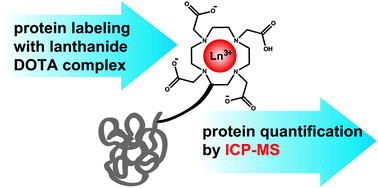DOTA based metal labels for protein quantification: a review
Abstract
Today, quantitative data play a pivotal role in the understanding of biological processes. This is particularly true for the proteome: protein quantification always follows protein identification. To obtain useful and reliable quantitative data, rather sophisticated strategies using electrospray and MALDI mass spectrometry have been developed, which allow relative and sometimes even absolute quantification. All of those strategies have merits and limitations. In order to overcome some of these limits, methods based on the reliable and sensitive detection and quantification of heavy metals present in proteins using inductively coupled plasma (ICP)-MS have been reported. With specific labels carrying heavy metals, the applicability of ICP-MS has been extended to almost every protein. One of such covalently bound metal tags, allowing the quantification of low abundant proteins, uses 1,4,7,10-tetraazacyclododecane N,N′,N′′,N′′-tetraacetic acid (DOTA) chelate complexes carrying lanthanides as the metal core. In this review the scope and limitations of peptide and protein quantification will be addressed. The metal tags do not only provide low detection limits, but also due to the large number of different lanthanides and lanthanide isotopes, multiplexing capabilities and previously unknown accuracy based on inherently possible isotope dilution methods came into reach. The developed workflows, including electrophoretic and chromatographic separation and preconcentration techniques, will be addressed to allow a comparison with already established procedures.

- This article is part of the themed collection: 2014 Young Analytical Scientists

 Please wait while we load your content...
Please wait while we load your content...